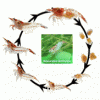-
Must Read SKF Articles
-
Posts
-
-
By sdlTBfanUK · Posted
It has been a few weeks now and I have done a couple of large water changes. I tested the water parameters this morning, GH6 and KH2, TDS 140 and PH 7.5. Obviously the PH is off but there isn't anything in the tank that should cause the PH to rise to this figure so I will just run the tank for another month with 10% weekly water changes (probably just with RO water) and see where we are at that point. The RO water tests at PH6, and the KH and GH in the tank could come down as they are at the upper limits for Caridina shrimps! There are only about 10 very small snails in there at this point, but they seem to be doing well enough. -
By sdlTBfanUK · Posted
I believe these to be very rare in Australia so you may even consider making it a longer term plan and produce your own by starting with the best CRS you can get as that is where the pure lines started! Depends how patient and interested in the project you are, but would save money as well? If I recall correctly it takes from 8 generations of selective breeding? They sell them at micro aquatic shop but do not ship to Western Australia, but that means they are available in Australia. https://microaquaticshop.com.au/products/pure-red-line-grade-ss-shrimp Good luck and just maybe smeone on here may point you in the right direction or be able to supply you with some. -
By Jimmy · Posted
Hi Guys, Does anyone know where to buy PRL shrimps in WA, not the CRS please. Thanks Regards -
By Subtlefly · Posted
Yes it’s super accurate to position where I want now and stay there- I am satisfied. All the fish and shrimpers are doing excellent! Coming up on 4 years running!
-


Recommended Posts
Create an account or sign in to comment
You need to be a member in order to leave a comment
Create an account
Sign up for a new account in our community. It's easy!
Register a new accountSign in
Already have an account? Sign in here.
Sign In Now